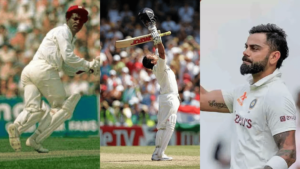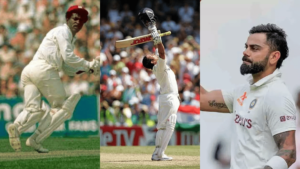
RevSportz Comment
The venue may have changed, from the old WACA to the new Perth Stadium, but the most isolated city in the world remains the final frontier for Test batting. The WACA was notorious for its snaking cracks and trampoline bounce, and while the new venue rarely features cracks that a bicycle tyre could disappear into, the bounce remains a huge challenge for batters.
But it’s also not an insurmountable challenge. The problem that we often see in the present day is a lack of comprehension. Too many teams and players have no clue what ‘intent’ means. More often than not, they confuse it with recklessness. Sachin Tendulkar, whose 114 at the old WACA, while still a teenager in February 1992, remains a masterclass for the ages, has explained it more than once to those that care to listen – ‘The decisive defensive shot or leave is as much a show of intent as the straight drive.’
Tendulkar walked that talk. “India’s bedrock was a captivating 114 from Tendulkar from 161 balls with 16 fours, the bulk of them square cuts,” wrote the Wisden Almanack. “He came in at 69 for two and was ninth out at 240, after 228 minutes, and a record ninth-wicket stand for India against Australia, of 81, with More. On the third morning, as he ran out of partners, he scored his second 50 from 55 balls.”
The highlights packages will only show the 16 fours, not the tap-and-run singles, the solid defensive pushes or the shouldering arms to dozens of balls. Of the 161 balls that he faced, more than 100 were dots. Yet, he still scored at more than four an over, rare in Test cricket at the time. That is intent, not trying to throw the kitchen sink and assorted plumbing at every ball.
You don’t even have to go that far back either. The first Test that the Perth Stadium hosted in 2018 featured one of the game’s great centuries, from Virat Kohli. Kohli batted six hours and 13 minutes for his 123, with 13 fours and one six. There were nearly 200 dots in his 257-ball effort. In a match where the next-best score was 72, it was an object lesson in eschewing natural instincts and ego in favour of a method that worked.
Just bear in mind that Kohli alone batted longer than either England innings lasted in this first Ashes Test. Yet, how many of the England batters could point to pitch misbehaviour as a reason for their dismissals? Some of the shots would have been an eyesore in a T10 thrash, and betrayed an utter lack of respect for both conditions and opposition bowling.
Besides, even a T20-style assault can be calculated rather than mindless. In December 1975, Roy Fredericks smashed a 71-ball century at the WACA on his way to 169 off 145 balls. “There was Lillee hurling down his thunderbolts and Thomson bowling like the wind, and Freddo cutting and pulling like a man possessed,” wrote Ashley Mallett, Australia’s off-spinner, in The Cricket Monthly many years later. “There was many a time when he cut at lifting deliveries, and at the precise instant he struck the ball, both his feet were well clear of the ground.”
At the same time, Mallett made it a point to mention how clinically Fredericks targeted the gaps in the field – “I was fielding in the gully and nothing came anywhere near me, yet Freddo was cutting fiercely, the ball soaring over my head and to my left, round point.”
Lindsay Hassett, who played alongside Don Bradman and Stan McCabe, said on air for the ABC that it was the “greatest innings I’ve seen in Australia”. But there too, there were more than 50 balls you won’t see in any highlights, where Fredericks offered the dead bat or the leave. Intent? Yes, in spades? Folly and arrogance? Best avoided.
Follow Revsportz for latest sports news





